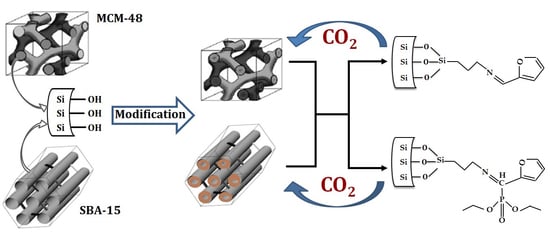CO2 Adsorption on the N- and P-Modified Mesoporous Silicas
Abstract
:1. Introduction
2. Materials and Methods
2.1. Materials
2.2. Preparation of SBA-15 and MCM-48
2.3. Preparation of a Schiff Base from APTES and Furfural
2.4. Preparation of Aminophosphonate Derivative of APTES
2.5. Modification of MCM-48 and SBA-15 with SAPTES
2.6. Modification of SBA-15 and MCM-48 with PAPTES
2.7. Methods
2.7.1. Materials Characterization
2.7.2. CO2 Adsorption
3. Results and Discussion
3.1. Synthesis of SAPTES
3.2. Synthesis of PAPTES
3.3. Modification of MCM-48 and SBA-15
3.4. Thermogravimetric Analysis (TGA)
3.5. Physicochemical Characterization of the Modified MCM-48 and SBA-15 Materials
3.6. CO2 Adsorption
4. Conclusions
Supplementary Materials
Author Contributions
Funding
Institutional Review Board Statement
Informed Consent Statement
Data Availability Statement
Acknowledgments
Conflicts of Interest
References
- Yong, Z.; Mata, V.; Rodrigues, A. Adsorption of carbon dioxide at high temperature—A review. Sep. Purif. Technol. 2002, 26, 195–205. [Google Scholar] [CrossRef]
- Liu, Y.; Shi, J.; Chen, J.; Ye, Q.; Pan, H.; Shao, Z.; Shi, Y. Dynamic performance of CO2 adsorption with tetraethylenepentamine-loaded KIT-6. Microporous Mesoporous Mater. 2010, 134, 16–21. [Google Scholar] [CrossRef]
- Min, J.G.; Kemp, K.C.; Hong, S.B. Zeolites ZSM-25 and PST-20: Selective Carbon Dioxide Adsorbents at High Pressures. J. Phys. Chem. C 2017, 121, 3404–3409. [Google Scholar] [CrossRef]
- Arab, P.; Rabbani, M.G.; Sekizkardes, A.K.; İslamoğlu, T.; El-Kaderi, H.M. Copper(I)-Catalyzed Synthesis of Nanoporous Azo-Linked Polymers: Impact of Textural Properties on Gas Storage and Selective Carbon Dioxide Capture. Chem. Mater. 2014, 26, 1385–1392. [Google Scholar] [CrossRef]
- Ahmadpour, A.; Do, D.D. The preparation of active carbons from coal by chemical and physical activation. Carbon 1996, 34, 471–479. [Google Scholar] [CrossRef]
- Krishnan, S.; Suneesh, C.V. Post-synthetic modification of tetraphenylcyclopentadienone based hypercrosslinked microporous polymers for selective adsorption of CO2. Mater. Today Commun. 2021, 27, 102251. [Google Scholar] [CrossRef]
- Sanz-Pérez, E.S.; Lobato, B.; Lopez-Anton, M.A.; Arencibia, A.; Sanz, R.; Martínez-Tarazona, M.R. Effectiveness of amino-functionalized sorbents for CO2 capture in the presence of Hg. Fuel 2020, 267, 117250. [Google Scholar] [CrossRef]
- Mafra, L.; Čendak, T.; Schneider, S.; Wiper, P.V.; Pires, J.; Gomes, J.R.B.; Pinto, L.M. Structure of Chemisorbed CO2 Species in Amine-Functionalized Mesoporous Silicas Studied by Solid-State NMR and Computer Modeling. J. Am. Chem. Soc. 2017, 139, 389–408. [Google Scholar] [CrossRef]
- Ozdemir, J.; Mosleh, I.; Abolhassani, M.; Greenlee, L.F.; Beitle, R.R.; Beyzavi, M.H. Covalent Organic Frameworks for the Capture, Fixation, or Reduction of CO2. Front. Energy Res. 2019, 7, 1. [Google Scholar] [CrossRef] [Green Version]
- Ünveren, E.E.; Monkul, B.Ö.; Sarıoğlan, Ş.; Karademir, N.; Alper, E. Solid amine sorbents for CO2 capture by chemical adsorption: A review. Petroleum 2017, 3, 37–50. [Google Scholar] [CrossRef]
- Knöfel, C.; Descarpentries, J.; Benzaouia, A.; Zeleňák, V.; Mornet, S.; Llewellyn, P.L.; Hornebecq, V. Functionalised micro-/mesoporous silica for the adsorption of carbon dioxide. Microporous Mesoporous Mater. 2007, 99, 79–85. [Google Scholar] [CrossRef]
- Huang, H.Y.; Yang, R.T.; Chinn, D.; Munson, C.L. Amine-Grafted MCM-48 and Silica Xerogel as Superior Sorbents for Acidic Gas Removal from Natural Gas. Ind. Eng. Chem. Res. 2003, 42, 2427–2433. [Google Scholar] [CrossRef]
- Ma, Y.; Wang, Z.; Xu, X.; Wang, J. Review on porous nanomaterials for adsorption and photocatalytic conversion of CO2. Chin. J. Catal. 2017, 38, 1956–1969. [Google Scholar] [CrossRef]
- Ravutsov, M.; Mitrev, Y.; Shestakova, P.; Lazarova, H.; Simeonov, S.; Popova, M. CO2 Adsorption on Modified Mesoporous Silicas: The Role of the Adsorption Sites. Nanomaterials 2021, 11, 2831. [Google Scholar] [CrossRef]
- Xu, X.; Song, C.; Miller, B.G.; Scaroni, A.W. Adsorption separation of carbon dioxide from flue gas of natural gas-fired boiler by a novel nanoporous ’molecular basket’ adsorbent. Fuel Processing Technol. 2005, 86, 1457–1472. [Google Scholar] [CrossRef]
- Ma, X.; Wang, X.; Song, C. ’Molecular basket’ sorbents for separation of CO2 and H2S from various gas streams. J. Am. Chem. Soc. 2009, 131, 5777–5783. [Google Scholar] [CrossRef]
- Samanta, A.; Zhao, A.; Shimizu, G.K.H.; Sarkar, P.; Gupta, R. Post-Combustion CO2 Capture Using Solid Sorbents: A Review. Ind. Eng. Chem. Res. 2012, 51, 1438–1463. [Google Scholar] [CrossRef]
- Plaza, M.G.; Pevida, C.; Arias, B.; Fermoso, J.; Arenillas, A.; Rubiera, F.; Pis, J.J. Application of thermogravimetric analysis to the evaluation of aminated solid sorbents for CO2 capture. J. Anal. Calorim 2008, 92, 601–606. [Google Scholar] [CrossRef]
- Su, F.; Lu, C.; Kuo, S.-C.; Zeng, W. Adsorption of CO2 on Amine-Functionalized Y-Type Zeolites. Energy Fuels 2010, 24, 1441–1448. [Google Scholar] [CrossRef]
- Fisher, J.C.; Tanthana, J.; Chuang, S.S.C. Oxide-supported tetraethylenepentamine for CO2 capture. Environ. Prog. Sustain. Energy 2009, 28, 589–598. [Google Scholar] [CrossRef]
- Harlick, P.J.E.; Sayari, A. Applications of Pore-Expanded Mesoporous Silica. 5. Triamine Grafted Material with Exceptional CO2 Dynamic and Equilibrium Adsorption Performance. Ind. Eng. Chem. Res. 2007, 46, 446–458. [Google Scholar] [CrossRef]
- Wei, J.; Shi, J.; Pan, H.; Su, Q.; Zhu, J.; Shi, Y. Thermal and hydrothermal stability of amino-functionalized SBA-16 and promotion of hydrophobicity by silylation. Microporous Mesoporous Mater. 2009, 117, 596–602. [Google Scholar] [CrossRef]
- Hiyoshi, N.; Yogo, K.; Yashima, T. Adsorption characteristics of carbon dioxide on organically functionalized SBA-15. Microporous Mesoporous Mater. 2005, 84, 357–365. [Google Scholar] [CrossRef]
- Wei, J.; Shi, J.; Pan, H.; Zhao, W.; Ye, Q.; Shi, Y. Adsorption of carbon dioxide on organically functionalized SBA-16. Microporous Mesoporous Mater. 2008, 116, 394–399. [Google Scholar] [CrossRef]
- Boukoussa, B.; Hakiki, A.; Bouazizi, N.; Beltrao-Nunes, A.-P.; Launay, F.; Pailleret, A.; Pillier, F.; Bengueddach, A.; Hamacha, R.; Azzouz, A. Mesoporous silica supported amine and amine-copper complex for CO2 adsorption: Detailed reaction mechanism of hydrophilic character and CO2 retention. J. Mol. Struct. 2019, 1191, 175–182. [Google Scholar] [CrossRef]
- Bhagiyalakshmi, M.; Park, S.D.; Cha, W.S.; Jang, H.T. Development of TREN dendrimers over mesoporous SBA-15 for CO2 adsorption. Appl. Surf. Sci. 2010, 256, 6660–6666. [Google Scholar] [CrossRef]
- Vieillard, J.; Bouazizi, N.; Bargougui, R.; Brun, N.; Nkuigue, P.F.; Oliviero, E.; Thoumire, O.; Couvrat, N.; Woumfo, E.D.; Ladam, G.; et al. Cocoa shell-deriving hydrochar modified through aminosilane grafting and cobalt particle dispersion as potential carbon dioxide adsorbent. Chem. Eng. J. 2018, 342, 420–428. [Google Scholar] [CrossRef]
- Kim, K.C.; Jang, S.S. Molecular Simulation Study on Factors Affecting Carbon Dioxide Adsorption on Amorphous Silica Surfaces. J. Phys. Chem. C 2020, 124, 12580–12588. [Google Scholar] [CrossRef]
- Nair, A.K.N.; Cui, R.; Sun, S. Overview of the Adsorption and Transport Properties of Water, Ions, Carbon Dioxide, and Methane in Swelling Clays. ACS Earth Space Chem. 2021, 5, 2599–2611. [Google Scholar] [CrossRef]
- He, Y.; Zhu, X.; Li, Y.; Peng, C.; Hu, J.; Liu, H. Efficient CO2 capture by triptycene-based microporous organic polymer with functionalized modification. Microporous Mesoporous Mater. 2015, 214, 181–187. [Google Scholar] [CrossRef]
- Issa, Y.M.; Hassib, H.B.; Abdelaal, H.E. 1H NMR, 13C NMR and mass spectral studies of some Schiff bases derived from 3-amino-1,2,4-triazole, Spectrochimica acta. Part A. Mol. Biomol. Spectrosc. 2009, 74, 902–910. [Google Scholar] [CrossRef]
- Kraicheva, I.; Finocchiaro, P.; Failla, S. Synthesis and nmr spectroscopic study of new 5-methylfuryl-containing schiff bases and related bis(aminophosphonates). Phosphorus Sulfur Silicon Relat. Elem. 2004, 179, 2345–2354. [Google Scholar] [CrossRef]
- Kraicheva, I.; Bogomilova, A.; Tsacheva, I.; Momekov, G.; Momekova, D.; Troev, K. Synthesi. NMR characterization and in vitro cytotoxicity evaluation of new poly(oxyethylene aminophosphonate)s. Eur. J. Med. Chem. 2010, 45, 6039–6044. [Google Scholar] [CrossRef]
- Kwiatkowski, S.; Leszczyński, J.; Teca, I. Molecular structure and infrared spectra of furan, thiophene, selenophene and their 2,5-N and 3,4-N derivatives: Density functional theory and conventional post-Hartree-Fock MP2 studies. J. Mol. Struct. 1997, 436-437, 451–480. [Google Scholar] [CrossRef]
- Troev, K. Chemistry and Application of H-Phosphonates, 1st ed.; Elsevier Science Ltd: Amsterdam, The Netherlands, 2006; p. 336. [Google Scholar] [CrossRef]
- Chen, Q.; Luo, M.; Hammershøj, P.; Zhou, D.; Han, Y.; Laursen, B.W.; Yan, C.-G.; Han, B.-H. Microporous polycarbazole with high specific surface area for gas storage and separation. J. Am. Chem. Soc. 2012, 134, 6084–6087. [Google Scholar] [CrossRef]
- Yaseen, A.A.; Al-Tikrity, E.T.B.; El-Hiti, G.A.; Ahmed, D.S.; Baashen, M.A.; Al-Mashhadani, M.H.; Yousif, E. A Process for Carbon Dioxide Capture Using Schiff Bases Containing a Trimethoprim Unit. Processes 2021, 9, 707. [Google Scholar] [CrossRef]
- Ahmed, D.S.; El-Hiti, G.A.; Yousif, E.; Hameed, A.S.; Abdalla, M. New Eco-Friendly Phosphorus Organic Polymers as Gas Storage Media. Polymers 2017, 9, 336. [Google Scholar] [CrossRef]
- Pinto, M.L.; Mafra, L.; Guil, J.M.; Pires, J.; Rocha, J. Adsorption and Activation of CO2 by Amine-Modified Nanoporous Materials Studied by Solid-State NMR and 13CO2 Adsorption. Chem. Mater. 2011, 23, 1387–1395. [Google Scholar] [CrossRef]
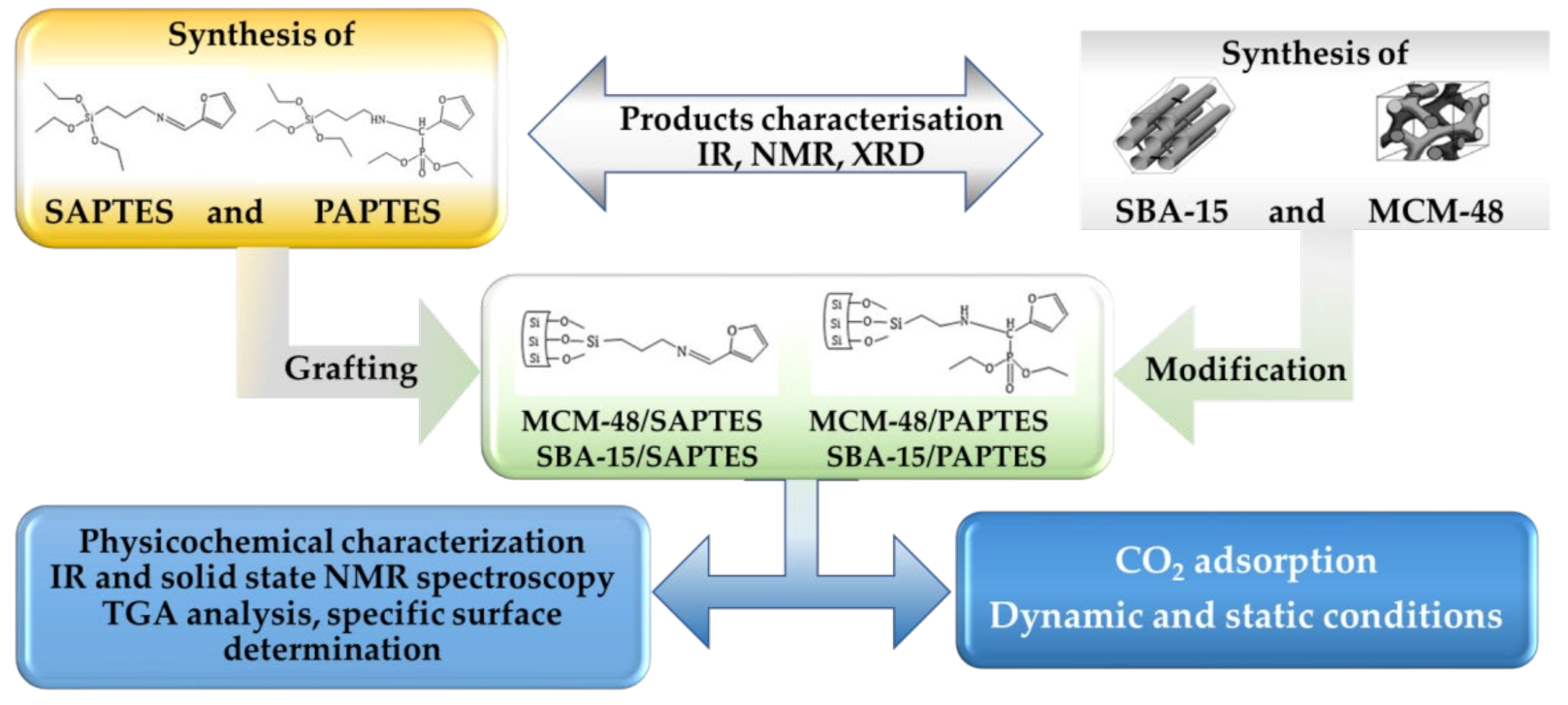

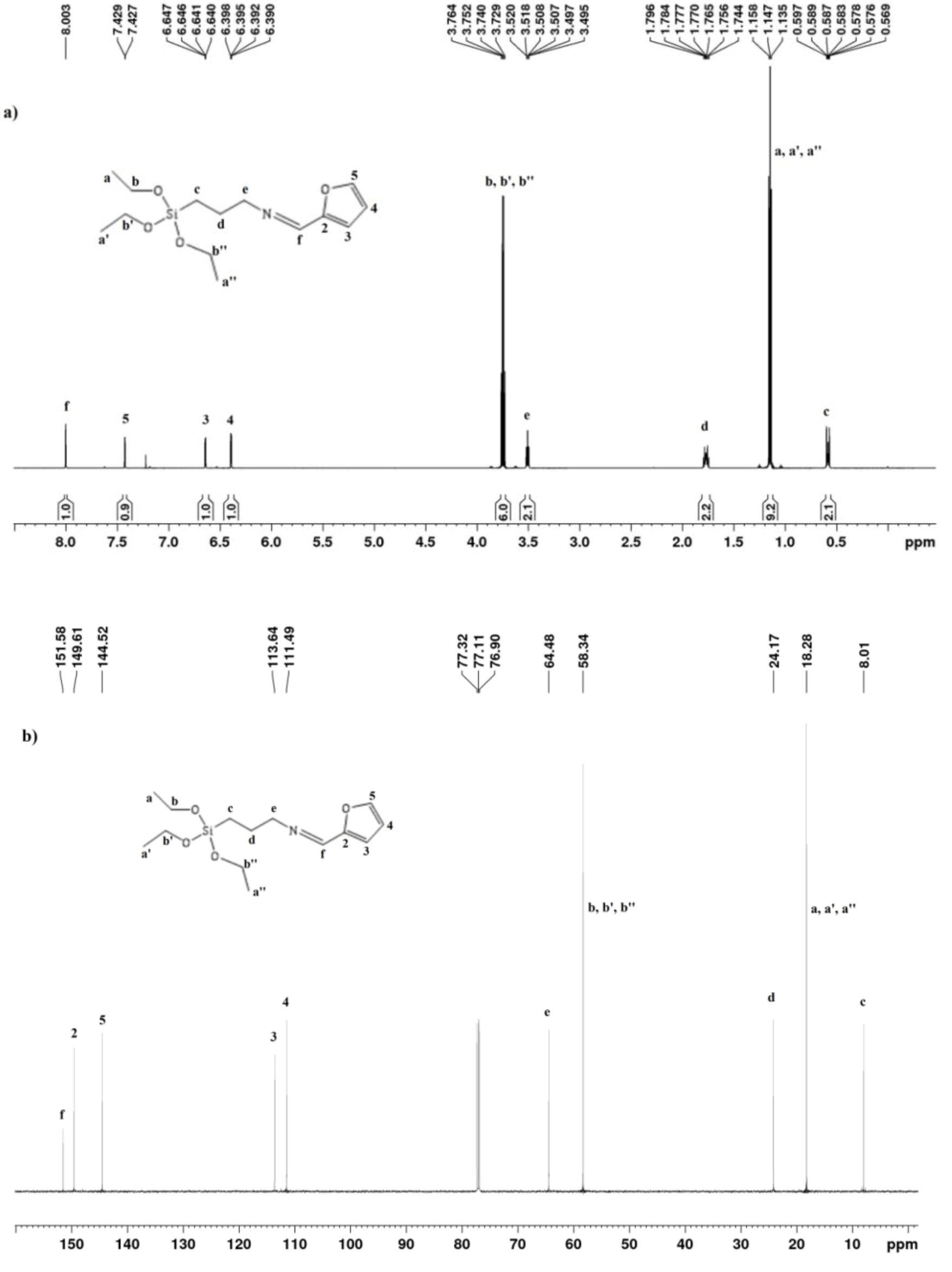
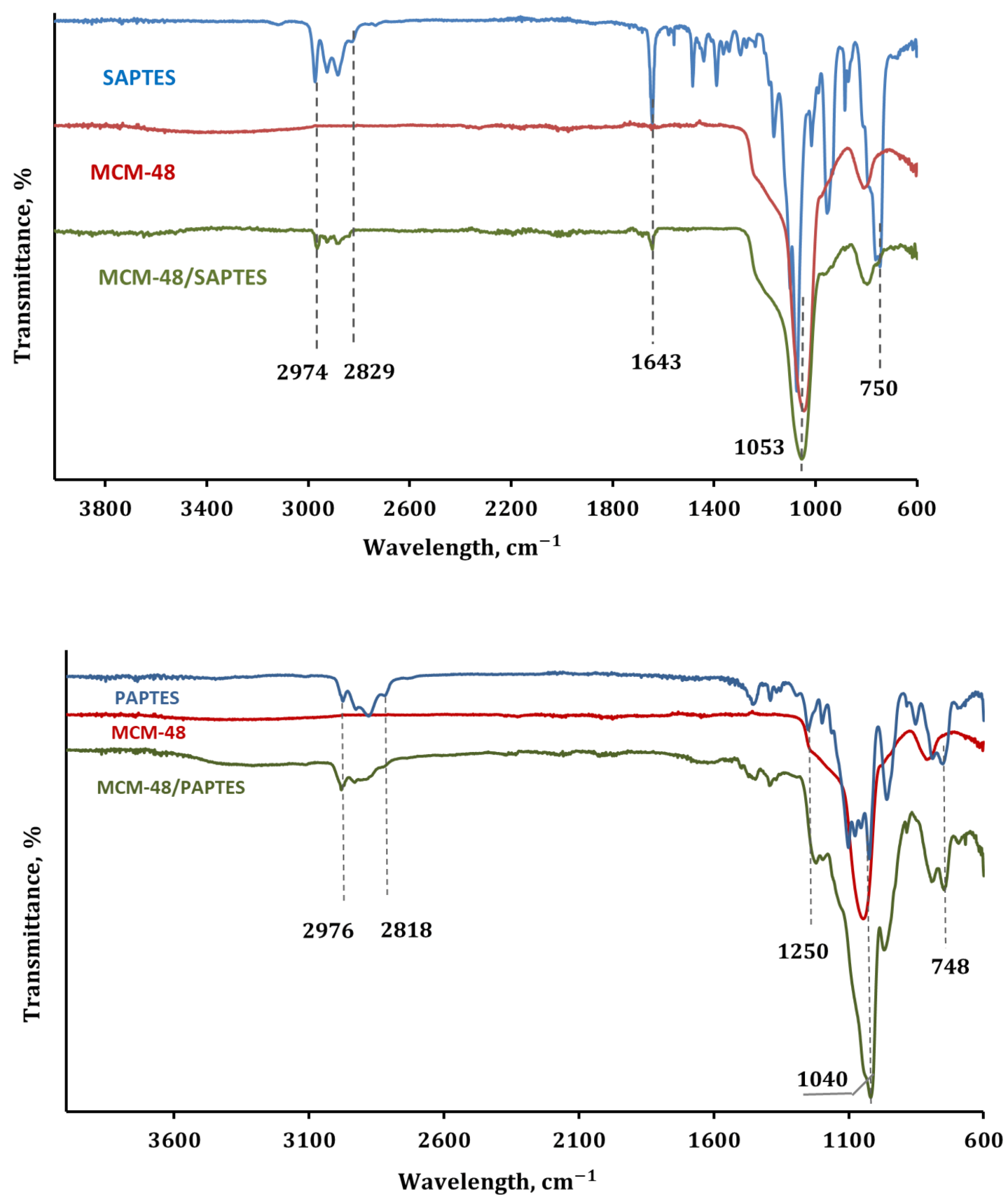

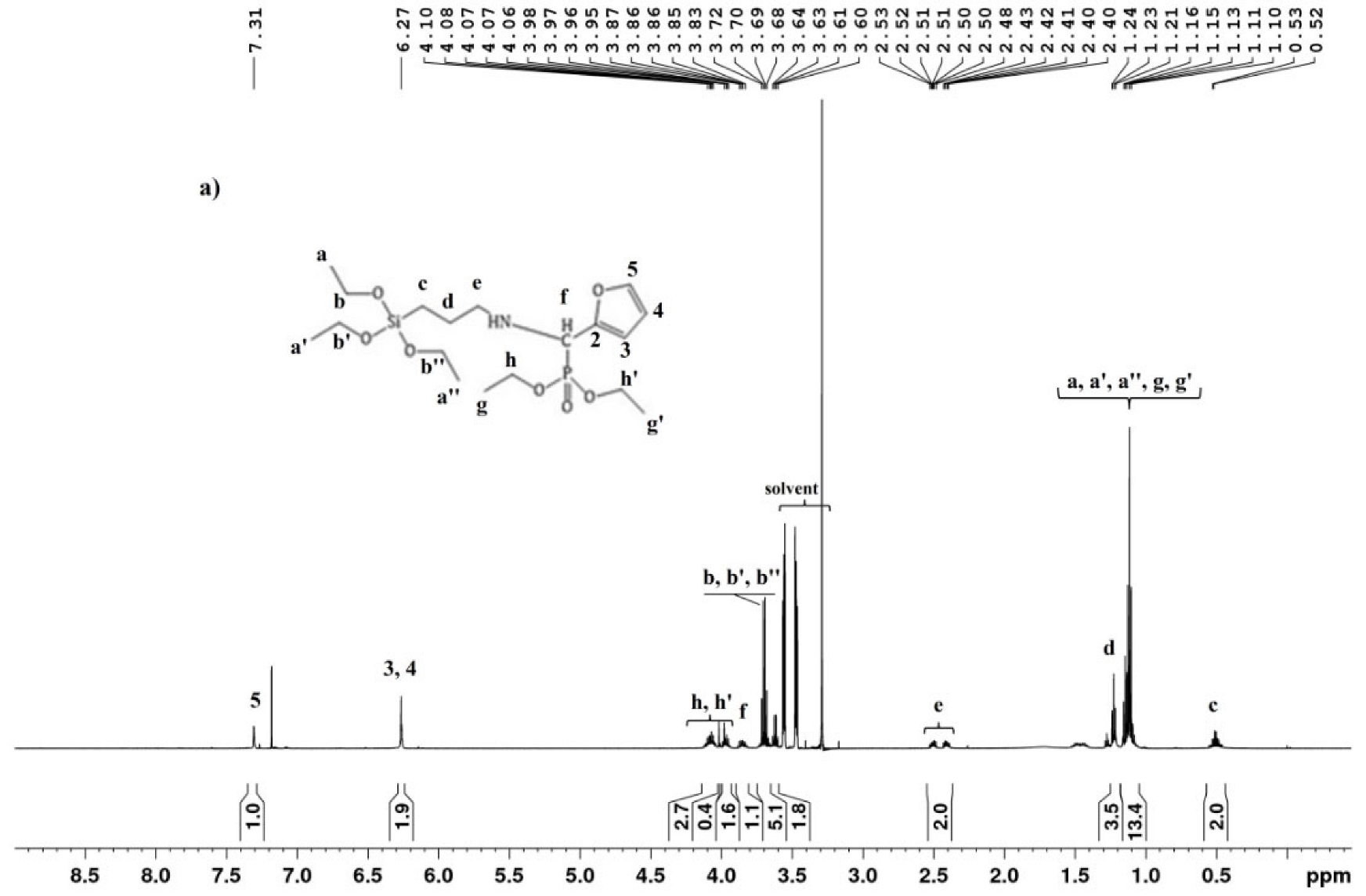
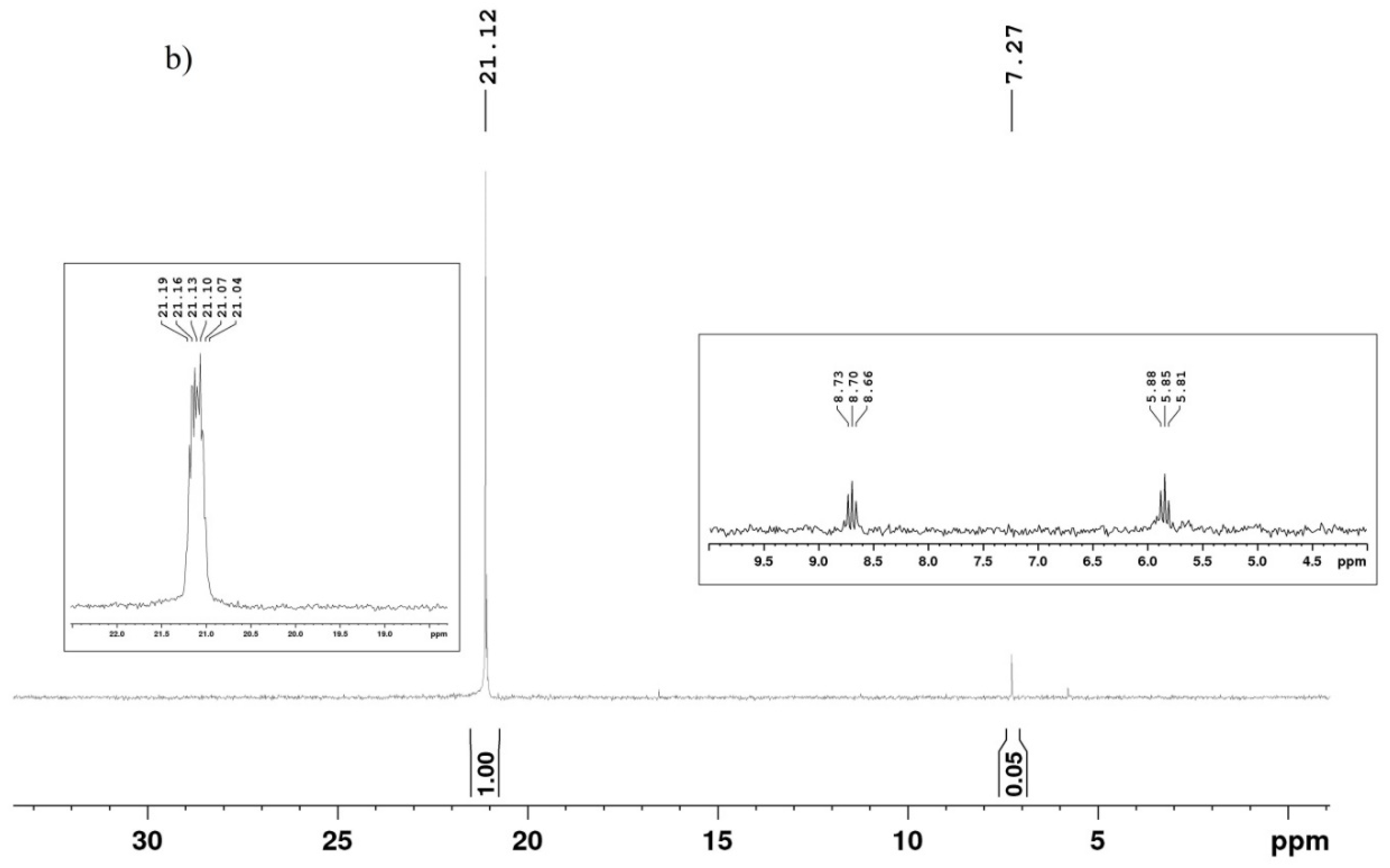

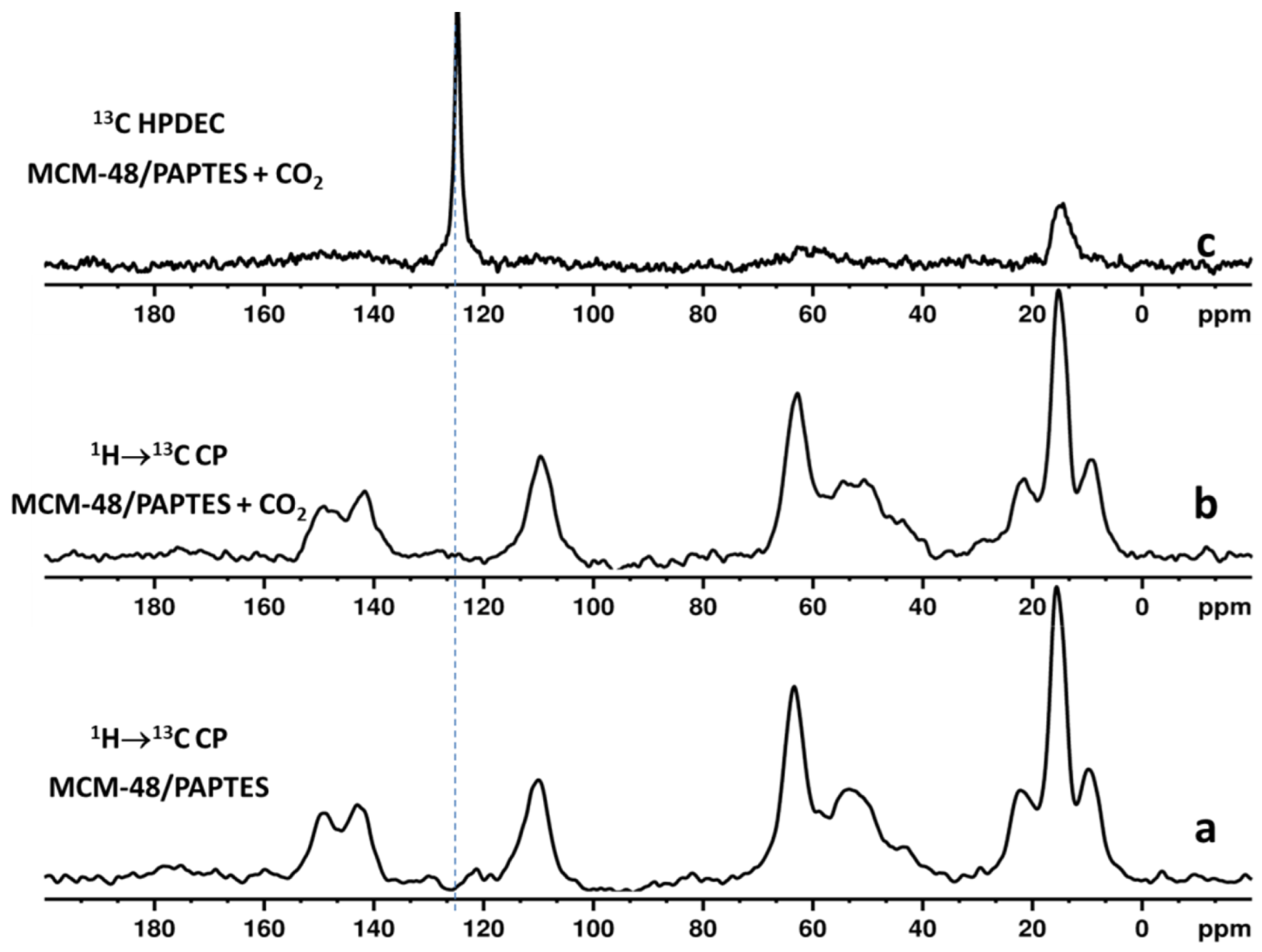
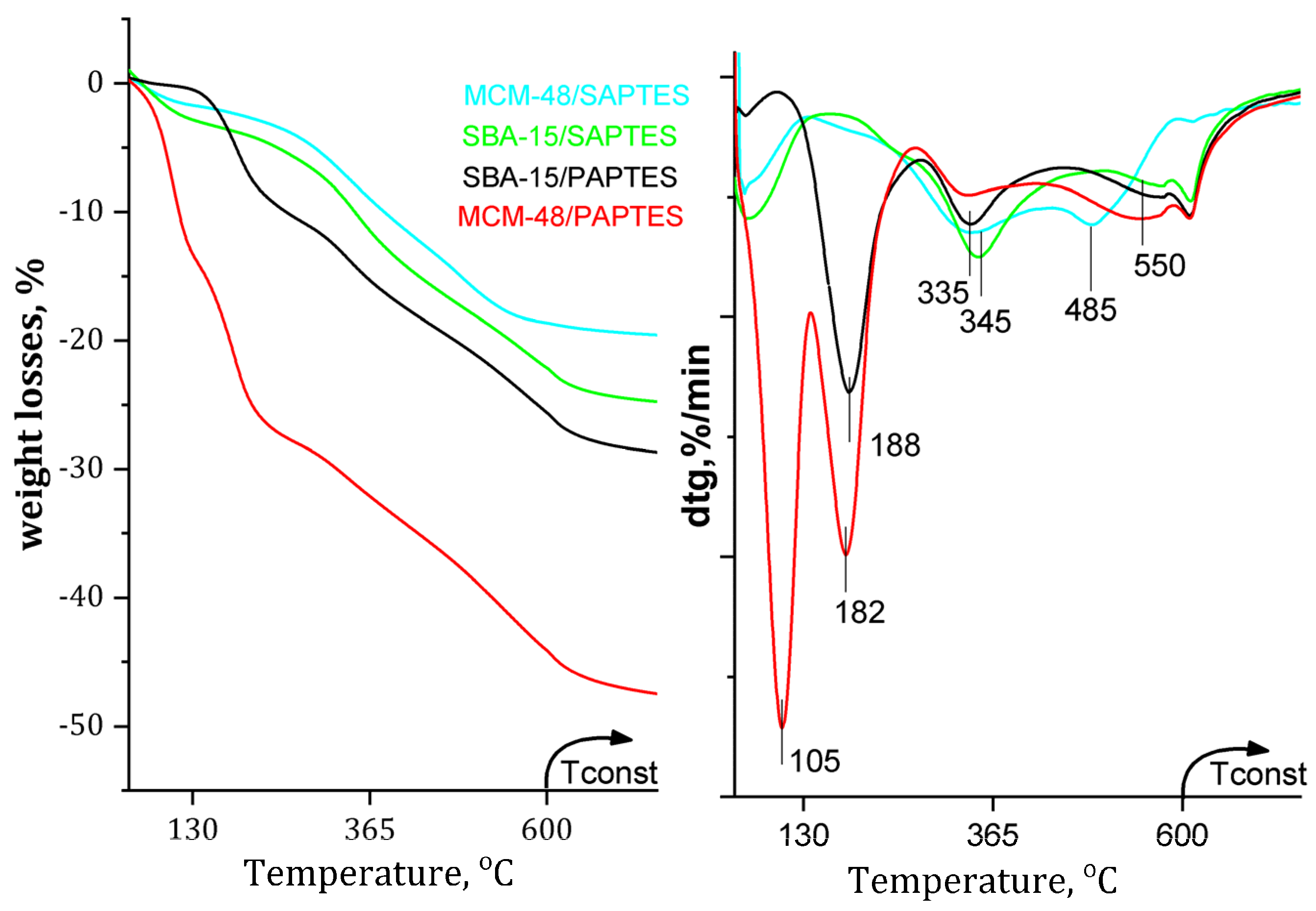
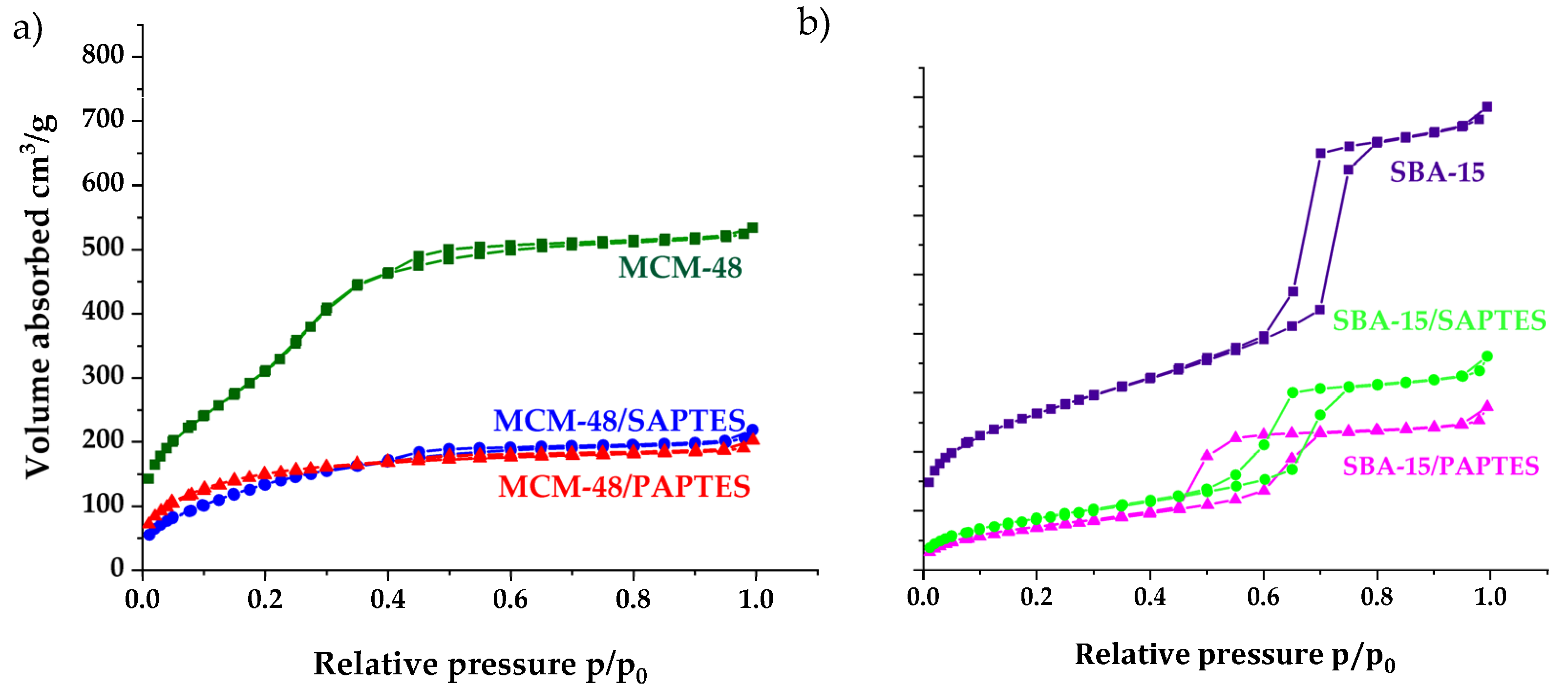
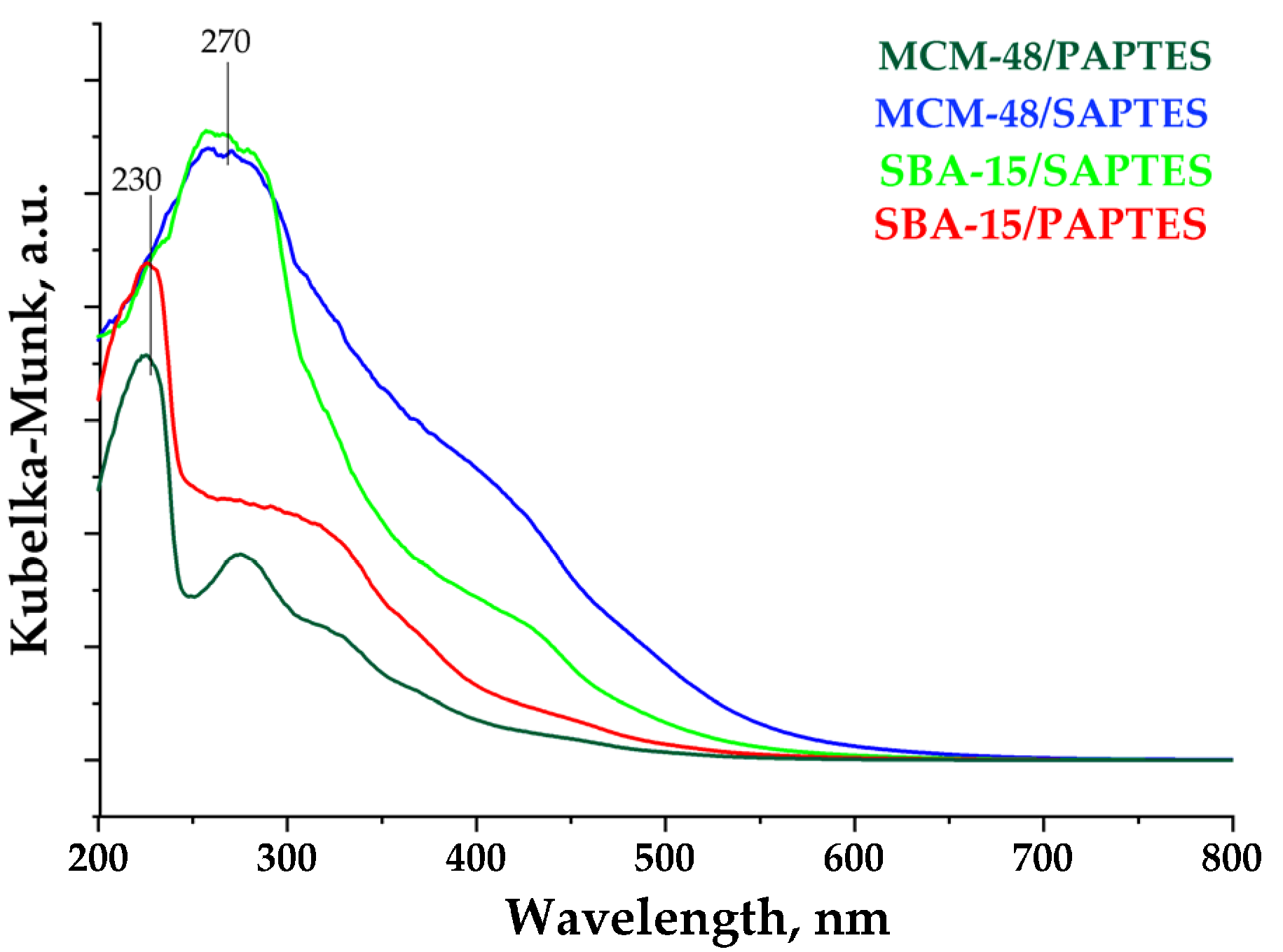
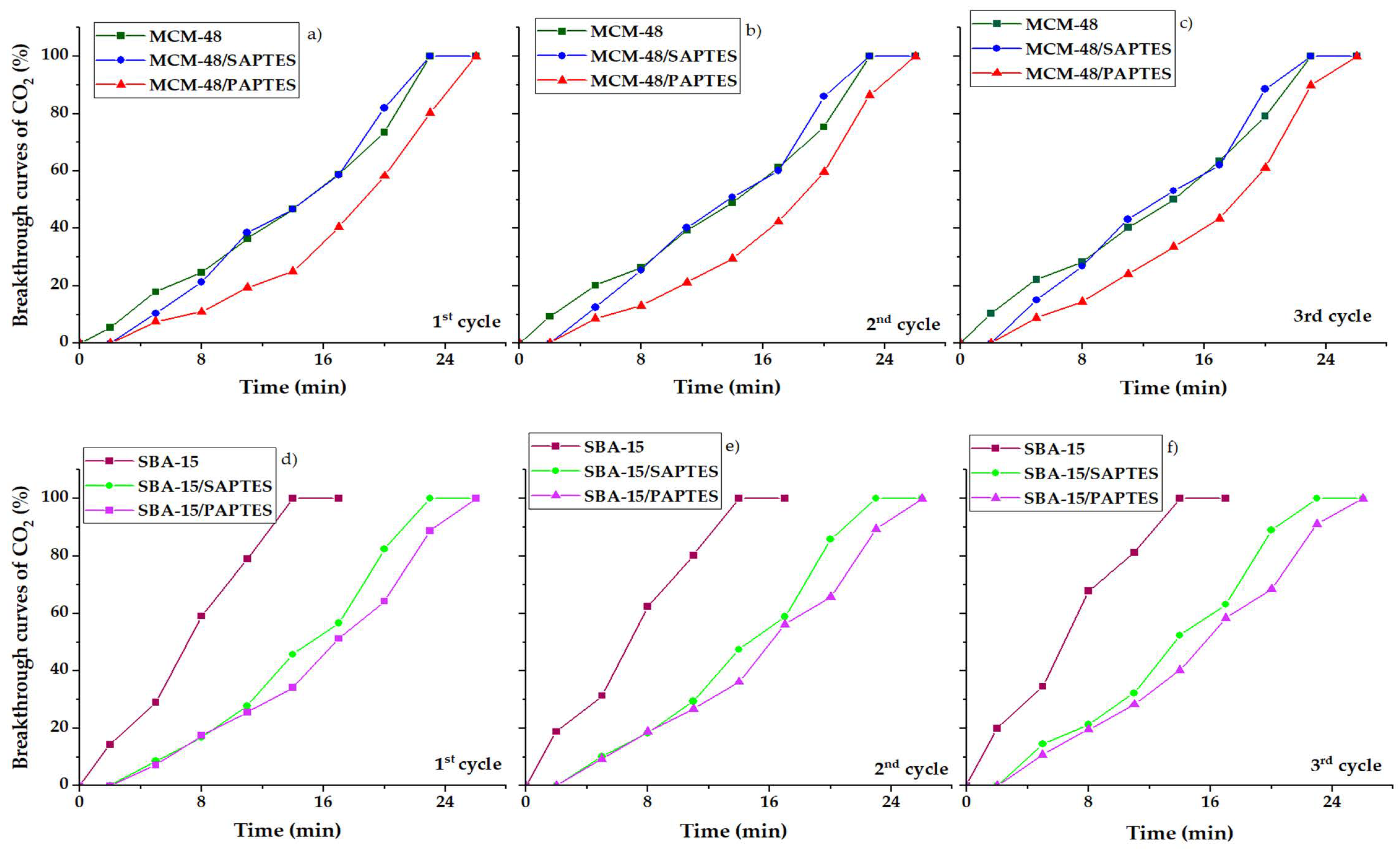
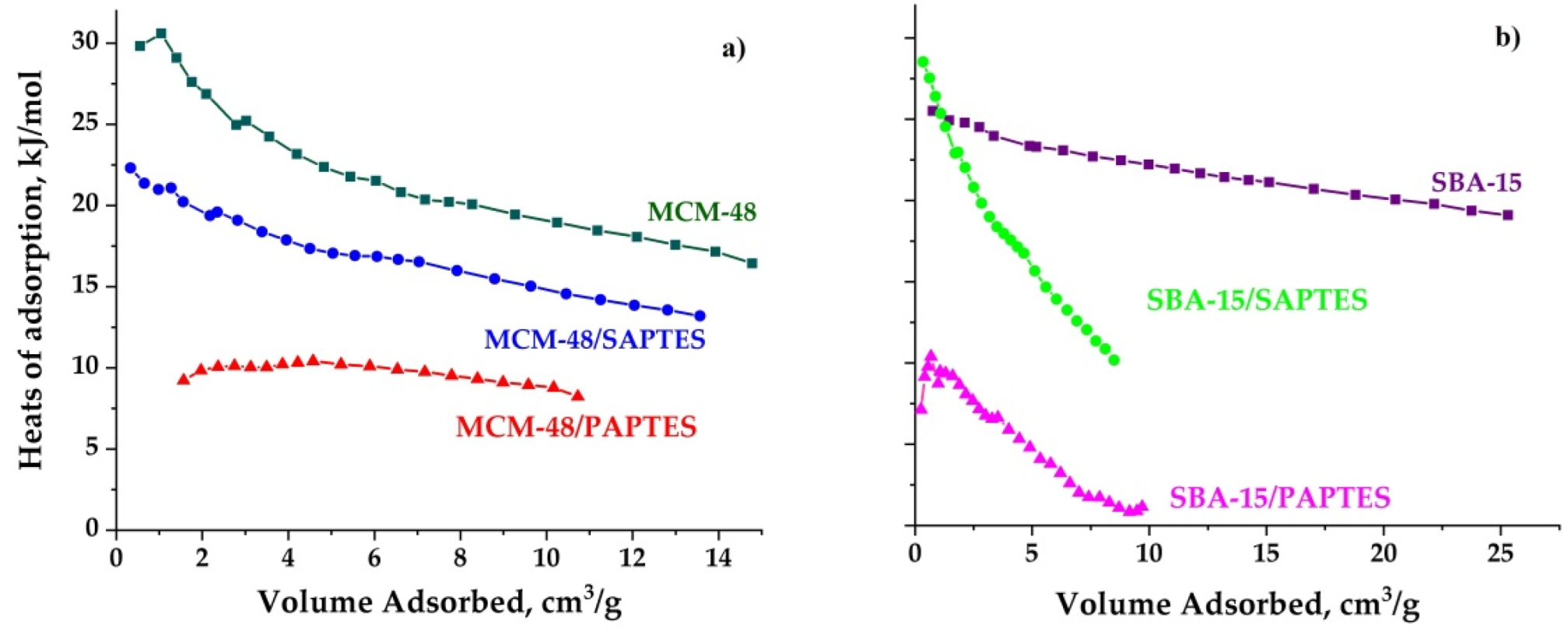
| Sample Name | SBET (m2/g) | Pore Volume (cm3/g) | Pore Diameter (nm) | Content of the Grafted Groups % |
|---|---|---|---|---|
| MCM-48 | 1235 | 0.83 | 2.4 | - |
| MCM-48/SAPTES | 439 | 0.35 | 3.1 | 19.07 |
| MCM-48/PAPTES | 516 | 0.31 | 3.1 | 40.20 |
| SBA-15 | 926 | 1.22 | 6.8 | - |
| SBA-15/SAPTES | 318 | 0.56 | 6.6 | 23.25 |
| SBA-15/PAPTES | 265 | 0.43 | 5.6 | 28.85 |
| Sample | Adsorption of CO2, mmol/g (1 Cycle) | Adsorption of CO2, mmol/g (2 Cycle) | Adsorption of CO2, mmol/g (3 Cycle) |
|---|---|---|---|
| MCM-48 | 2.50 | 2.40 | 2.40 |
| MCM-48/SAPTES | 4.60 | 4.50 | 4.45 |
| MCM-48/PAPTES | 4.20 | 4.00 | 4.05 |
| SBA-15 | 1.30 | 1.30 | 1.30 |
| SBA-15/SAPTES | 2.50 | 2.40 | 2.40 |
| SBA-15/PAPTES | 2.80 | 2.75 | 2.70 |
| Sample | Adsorption Conditions | Adsorption of CO2, mmol/g | Reference |
|---|---|---|---|
| TEPA/Y zeolite (Si/Al = 60) | 60 °C, 15% CO2 and 7% water vapor | 4.27 | [19] |
| amino-SBA-15 | 15 kPa CO2 at 60 °C | 1.80 | [22] |
| N-(2-aminoethyl)-3-aminopropyl/SBA-16 | 30 bars, 27 °C | 5.40 | [24] |
| 50% PEI/SBA-15 | 75 °C, 0.15 bar CO2 | 3.18 | [16] |
| 40% DETA/Al2O3 | 25 °C | 1.83 | [18] |
| 1-methylpiperazine/MCM-48 | 25 °C, 1 atm, 3 vol.% CO2/N2 at a flow rate of 30 mL/min | 4.20 | [11] |
| MCM-48 | 25 °C, 1 atm, 3 vol.% CO2/N2 at a flow rate of 30 mL/min | 2.50 | This work |
| MCM-48/SAPTES | 25 °C, 1 atm, 3 vol.% CO2/N2 at a flow rate of 30 mL/min | 4.60 | This work |
Publisher’s Note: MDPI stays neutral with regard to jurisdictional claims in published maps and institutional affiliations. |
© 2022 by the authors. Licensee MDPI, Basel, Switzerland. This article is an open access article distributed under the terms and conditions of the Creative Commons Attribution (CC BY) license (https://creativecommons.org/licenses/by/4.0/).
Share and Cite
Tumurbaatar, O.; Lazarova, H.; Popova, M.; Mitova, V.; Shestakova, P.; Koseva, N. CO2 Adsorption on the N- and P-Modified Mesoporous Silicas. Nanomaterials 2022, 12, 1224. https://doi.org/10.3390/nano12071224
Tumurbaatar O, Lazarova H, Popova M, Mitova V, Shestakova P, Koseva N. CO2 Adsorption on the N- and P-Modified Mesoporous Silicas. Nanomaterials. 2022; 12(7):1224. https://doi.org/10.3390/nano12071224
Chicago/Turabian StyleTumurbaatar, Oyundari, Hristina Lazarova, Margarita Popova, Violeta Mitova, Pavletta Shestakova, and Neli Koseva. 2022. "CO2 Adsorption on the N- and P-Modified Mesoporous Silicas" Nanomaterials 12, no. 7: 1224. https://doi.org/10.3390/nano12071224
APA StyleTumurbaatar, O., Lazarova, H., Popova, M., Mitova, V., Shestakova, P., & Koseva, N. (2022). CO2 Adsorption on the N- and P-Modified Mesoporous Silicas. Nanomaterials, 12(7), 1224. https://doi.org/10.3390/nano12071224






